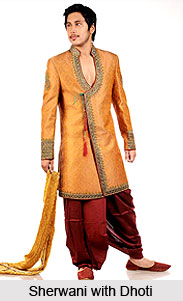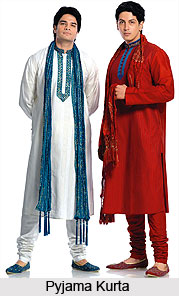 Costumes for Indian men have traditionally comprised the Dhoti and Kurta. However the most unique feature of the Indian culture is that every state of the country has its own distinct traditional clothing for men and women. Thus in keeping with this diversity, the traditional costumes for men include Sherwani- Churidar, Kurta- Pajamas, Dhoti, Jodhpuris, Angarkha, Angavastram and Turbans. These traditional costumes have always been a distinct part of India, and everyone identified each other from the costumes they used to wear.
Costumes for Indian men have traditionally comprised the Dhoti and Kurta. However the most unique feature of the Indian culture is that every state of the country has its own distinct traditional clothing for men and women. Thus in keeping with this diversity, the traditional costumes for men include Sherwani- Churidar, Kurta- Pajamas, Dhoti, Jodhpuris, Angarkha, Angavastram and Turbans. These traditional costumes have always been a distinct part of India, and everyone identified each other from the costumes they used to wear.
Dhoti
The dhoti is the typically traditional style of Indian men"s wear. It is essentially a rectangular piece of cloth which is wrapped in a rather complex manner around the waist and the legs. As regards the way of wearing a dhoti, there are more than 60 different ways of wearing it. The dhoti is white or cream in colour most of the times. However, black and other darker hues may also be resorted to at times in order to create more vivid and vibrant ensembles. In northern India, it is worn with a Kurta on top, the combination known simply as "Dhoti Kurta".
Churidar
 A Churidar is a baggy drawstring trouser that bunches up tightly along the lower calf. Worn traditionally with Kameez or Kurta, its name comes from the word "Choori" meaning bangles. The bunched folds along the bottom half of the calf gives the effect of several bangles worn together. It is essentially a long-fitting pyjama worn by the North Indian groom. Churidars are usually fine muslins or cottons, in white colour. The traditional churidar is tied with a Nara at the waist. A Churidar is a perfect accompaniment to sherwanis as well.
A Churidar is a baggy drawstring trouser that bunches up tightly along the lower calf. Worn traditionally with Kameez or Kurta, its name comes from the word "Choori" meaning bangles. The bunched folds along the bottom half of the calf gives the effect of several bangles worn together. It is essentially a long-fitting pyjama worn by the North Indian groom. Churidars are usually fine muslins or cottons, in white colour. The traditional churidar is tied with a Nara at the waist. A Churidar is a perfect accompaniment to sherwanis as well.
Angavastram
Angavastram is pieces of cloth worn during festivals and auspicious events by men in India. This piece was generally wrapped round the waist, more or less in the manner observed on the sculptures of Sanchi, Amaravati and Nagarjuni Konda by Brahmin classes when within the temple or when actually bowing to the deities therein installed. Angavastram is available in pure silk. It can be worn quite well by itself, or along with the matching Angavastram draped over the shoulder, one can wear the cotton handloom dhoti with a zari border.
Jodhpuris
Jodhpuris are one of the most elegant of Indian men"s wear. These traditional men"s wears are designed with lot of embroidery work like Phulkari, Zardoji and other heavy embroidery works. Thus embroidery has passed on from the female arena to men"s wear as well.
Sherwani
Sherwani has a timeless appeal, revealing its elegance as wedding attire. Sherwani is a long coat-like garment worn by men, very similar to an Achkan. It is worn over the Salwar-Kameez. The Sherwani coat fits close to the body, fastened in the front with buttons, and extends to slightly below knee-length. Sherwanis are usually embroidered or detailed in some way. It attains perfection with the superb fits and rich fabrics, embellished with embroidery that has been inspired by the diverse cultures of India.
Angarkha
Angarkha is a variation of the kurta, which ties in the front and is worn with a Churidar- kurta. There are Angarkhas with hand embroidery too. A trend that was started from the royal wearing of Mughals and is always had been a style of India.
Pagdi
In the Hindi Language, the turban is called a "Pagdi". The turban is a headdress, of Asian origin, consisting of a long scarf wound round the head or an inner hat. The turban comes in many shapes and sizes and the colour of turbans vary, with the cloth`s length being up to 45 meters. Early Persians wore a conical cap sometimes encircled by bands of cloth, which may be considered one of the origins of the modern turban.
Pyjama Kurta
The Pajama Kurta is another commonly worn traditional dress. The kurta is a long, loose garment which almost reaches the knees. The pyjama is like a drawstring trouser which is light in weight. Materials with a soft fabric are used to make the kurta and pyjama. Though traditionally cotton is used to make the garments, occasionally silk and satin may also be used. The pyjama kurta is an all-rounder, worn both on formal occasions such as Holi, religious ceremonies etc, as well as casually.
Fashion in India has undergone a constant process of evolution down the ages, from the Angarkhas, Choga, Achkan, Sherwani and much more. With the passage of time, the handloom fabric, plain look and simple dressing styles of men have changed vastly. Today men are becoming very fashion conscious especially in urban areas. In rural and semi-urban areas men are still adhered to the custom of Dhotis whereas in the urban areas, men prefer wearing shirts along with trousers made of various materials. Thus the Indian fashion scene for men has managed to retain its traditional roots while also adopting a modern outlook.





















